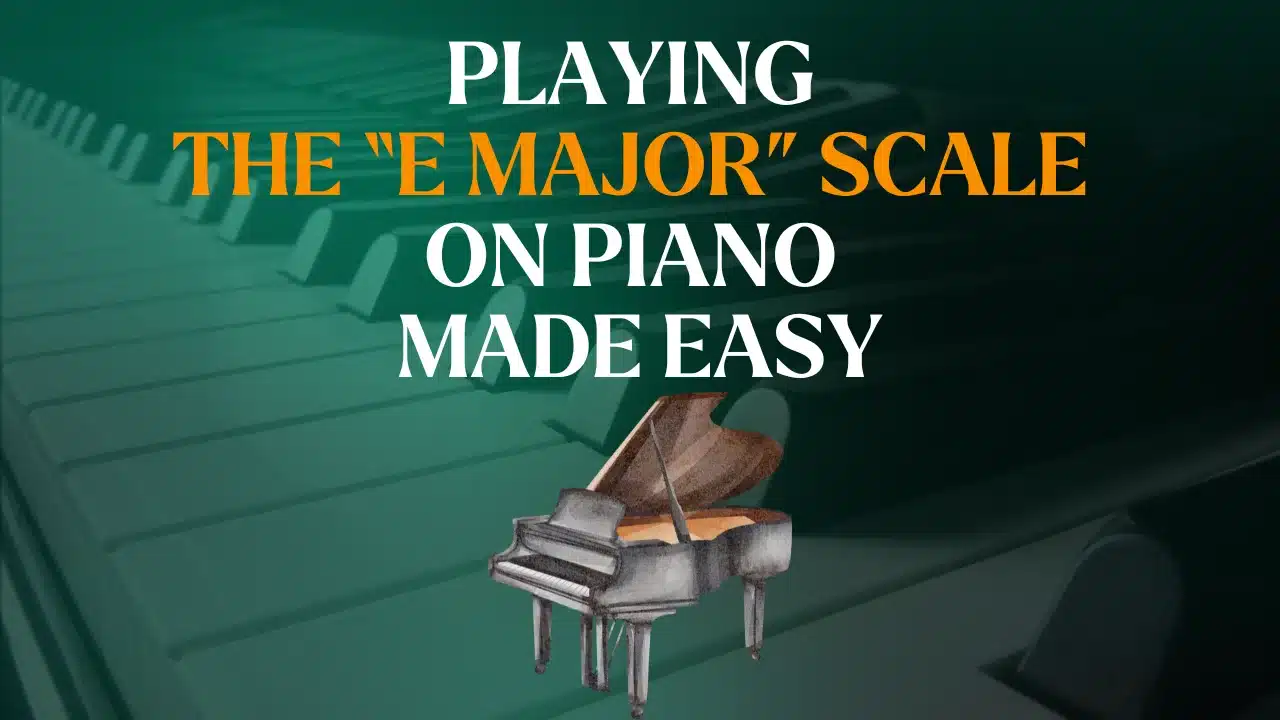- The E Major Scale Piano Notes
- Forming the E Major Scale on Piano Using Whole and Half Steps
- E Major Scale Piano Finger Position
- E Major Chord Inversions on Piano
- Practical Tips for Practicing Inversions
- E Major Family Chords
- How to Use E Major Scale Piano Chords
- Relative Minor of E Major Scale
- Relationship between E Major and C# Minor
- Practice Tips for Playing the E Major Scale
Learning the E major scale on piano is advantageous since it will not only take you through the white keys but also some of the black keys which helps you in improving your piano skills. In this guide you’ll learn what are the E major scale piano notes, its chord inversions, its family chords, E major scale piano finger position, relative minor, and other tips that will be useful when performing with the scale.
The E Major Scale Piano Notes
The E major scale consists of eight notes:
E, F#, G#, A, B, C#, D#, and E
Like all major scales, it follows a specific pattern of whole and half steps. In piano, an important aspect to learn, are the whole steps and half steps, which is the foundation in learning scales and melodies.
- Whole Step: It (or whole tone) is the space between two piano keys, there being only one key, black or white, in between. For example, between E and F# there is F – a white key; thus, it is a whole step from E to F#.
- Half Step: The smallest interval between two keys on the piano is a half step or, semitone, with no key in between them. For instance, G# and A would be half step because there are no keys between them.
Forming the E Major Scale on Piano Using Whole and Half Steps
To play the E major scale on your piano, follow the pattern of whole and half steps:
| From – To | E – F# | F# – G# | G# – A | A – B | B – C# | C# – D# | D# – E |
| Interval | Whole Step | Whole Step | Half Step | Whole Step | Whole Step | Whole Step | Half Step |
| Skipped Key | F | G | None | A# | C | D | None |
If you grasp these steps you could determine any key of the major scale, and feel more at ease playing them.
E Major Scale Piano Finger Position
The following finger positions must be used while play E major scale on piano to make the playing smooth as well as efficient. This will assist you to move from one note to another without having to make movements which are not required.
| Note | Right Hand Finger | Left Hand Finger |
| E | Thumb (1) | Little Finger (5) |
| F# | Index Finger (2) | Ring Finger (4) |
| G# | Middle Finger (3) | Middle Finger (3) |
| A | Thumb (1) | Index Finger (2) |
| B | Index Finger (2) | Thumb (1) |
| C# | Middle Finger (3) | Middle Finger (3) |
| D# | Ring Finger (4) | Index Finger (2) |
| E | Little Finger (5) | Thumb (1) |
Follow the mentioned E major scale piano finger position during your practice begin slowly and be conscious of which fingers to use or avoid. The exercise requires you to take more time initially but as it progresses, you will feel more comfortable to play the e major scale on your piano.
E Major Chord Inversions on Piano
When it comes to scales, chords can be interpreted as the ones that are formed on the notes of a scale. In E major scale, the first chord (or tonic chord) is the E major chord. The notes in this chord include E, G#, B.
Inversions are various approaches to the same chord that is formed by changing positions of the notes. Basically, inversions are important when it comes to playing chords because they help achieve sweet sounding progressions and variety in the music played.
The three variations of the E major scale are listed below:
- Root Position (E – G# – B): The E is the lowest note.
- First Inversion (G# – B – E): The G# is the lowest note.
- Second Inversion (B – E – G#): The B is the lowest note.
Here’s a simple table of the E major chord and its inversions for easy reference:
| Inversion | Notes | Right HandFinger Position (RH) | Left HandFinger Position (LH) |
| Root Position | E – G# – B | 1 (E), 3 (G#), 5 (B) | 5 (E), 3 (G#), 1 (B) |
| First Inversion | G# – B – E | 1 (G#), 2 (B), 5 (E) | 5 (G#), 3 (B), 1 (E) |
| Second Inversion | B – E – G# | 1 (B), 2 (E), 5 (G#) | 5 (B), 3 (E), 1 (G#) |
Practical Tips for Practicing Inversions
- Play Slowly and Clearly: Before progressing with the speed of playing songs, you need to make sure that you play each note with lots of clarity.
- Use a Metronome: This way, you will be able to keep the right time while practicing the inversions.
- Practice Each Inversion Separately: First, make yourself comfortable with one inversion before you move on to the next one. This way, you can excel in all the variations without getting confused.
- Explore with Various Rhythms: Changing the rhythm helps you to get familiar with the chord positions.
E Major Family Chords
All the chords made from the notes of the E major scale are a part of the E major family. These chords are made by skipping every other note, which helps you to create rich music. Learning these piano chords will help you to play better and make your own songs.
The scale degree, chord and its notes are tabulated below:
| Scale Degree | I | ii | iii | IV | V | vi | vii° |
| Chord | E Major | F# Minor | G# Minor | A Major | B Major | C# Minor | D# Diminished |
| Notes | E G# B | F# A C# | G# B D# | A C# E | B D# F# | C# E G# | D# F# A |
- E Major (I): This is the root chord of the E major scale. It sounds clear.
- F# Minor (ii): This minor chord is used to add a soft touch to your music.
- G# Minor (iii): This is a minor chord that adds a low and dramatic touch.
- A Major (IV): This major chord adds richness and clarity to your music.
- B major (V): This is the dominant chord that builds up tension. It frequently occurs at the ends of phrases.
- C# Minor (vi): The relative minor chord, sharing the same notes as the E major scale but with a different tonal center. It has a gloomy sound.
- D# Diminished (vii°): A diminished chord that adds a sense of disturbing but appropriate feel, often leading back to the E major chord.
How to Use E Major Scale Piano Chords
- Chord Progressions: Use these chords to create simple progressions like I-IV-V (E – A – B) or ii-V-I (F# minor – B – E), which are foundational in many songs.
- Experiment with Inversions: Try playing different inversions of these chords to create smoother transitions between them.
- Build Emotional Contrast: Use major chords to create bright, happy sections, and minor or diminished chords to add emotional depth or tension to your music.
The E major family chords are critical in developing harmonious as well as an interesting music segment in the key of E major. By excelling these chords, you will be better equipped to play, compose or even analyze music which makes a great start in your piano learning process.
Relative Minor of E Major Scale
This is very much related to a major scale. They use the same number of sharps or flats as the major scale but one starts on a different note. In other words, a relative minor is found beginning on the 6th degree of the major scale. The 6th note in the E major scale is C#, making it the relative minor of E major.
Relationship between E Major and C# Minor
- Shared Keys: Both E major and C# minor have four sharps (F#, C#, G#, and D#) in their scales.
- Emotional Contrast: While E major sounds bright and uplifting, C# minor has a more melancholic and reflective quality, providing a pleasant contrast in the music that you compose.
| Scale | 1st | 2nd | 3rd | 4th | 5th | 6th | 7th | 8th( Octave) |
| E Major | E | F# | G# | A | B | C# | D# | E |
| C# Minor | C# | D# | E | F# | G# | A | B | C# |
Practice Tips for Playing the E Major Scale
- Start Slowly: Start from a slow pace so as to always ensure that proper fingers are being used and correct timing is being followed.
- Use a Metronome: When using a metronome you are able to keep track of the tempos and ensure that you do not rush the song.
- Focus on Smooth Transitions: While sliding from one note to another, especially from your thumb in your right hand or middle finger in your left hand, do so gently without any hurry.
- Practice Both Hands Separately: You should begin to play each hand alone, until the fingers have been memorized and be ready to play together. Then try playing it with both hands simultaneously.
- Increase Speed Gradually: After you have familiarized yourself with the notes and finger placement, begin to speed up slightly. This will help in developing muscle memory and flexibility of the fingers.
As for the E major scale, this one, despite containing both white and black keys, tends to be the most effective sequence for developing the use of both hands in the beginning. It also assists in building finger independence, hand coordination as well as muscle memory. The black keys also help to have a proper hand position which plays a vital role in shaping the kind of playing technique that the pianist wants to adopt. In the same regard learning the E major scale can establish confidence in oneself and challenge one’s self to advancing pieces.





























